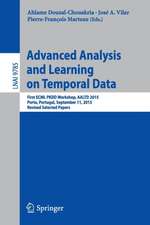Computational and Robotic Models of the Hierarchical Organization of Behavior
Editat de Gianluca Baldassarre, Marco Mirollien Limba Engleză Hardback – 2 dec 2013
This book is a comprehensive overview of the state of the art on the modeling of the hierarchical organization of behavior in animals, and on its exploitation in robot controllers. The book perspective is highly interdisciplinary, featuring models belonging to all relevant areas, including machine learning, robotics, neural networks, and computational modeling in psychology and neuroscience. The book chapters review the authors' most recent contributions to the investigation of hierarchical behavior, and highlight the open questions and most promising research directions. As the contributing authors are among the pioneers carrying out fundamental work on this topic, the book covers the most important and topical issues in the field from a computationally informed, theoretically oriented perspective. The book will be of benefit to academic and industrial researchers and graduate students in related disciplines.
| Toate formatele și edițiile | Preț | Express |
|---|---|---|
| Paperback (1) | 648.95 lei 6-8 săpt. | |
| Springer Berlin, Heidelberg – 23 aug 2016 | 648.95 lei 6-8 săpt. | |
| Hardback (1) | 613.00 lei 38-44 zile | |
| Springer Berlin, Heidelberg – 2 dec 2013 | 613.00 lei 38-44 zile |
Preț: 613.00 lei
Preț vechi: 766.25 lei
-20% Nou
Puncte Express: 920
Preț estimativ în valută:
117.31€ • 122.02$ • 96.85£
117.31€ • 122.02$ • 96.85£
Carte tipărită la comandă
Livrare economică 11-17 aprilie
Preluare comenzi: 021 569.72.76
Specificații
ISBN-13: 9783642398742
ISBN-10: 364239874X
Pagini: 365
Ilustrații: VI, 358 p. 116 illus., 73 illus. in color.
Dimensiuni: 155 x 235 x 25 mm
Greutate: 0.69 kg
Ediția:2013
Editura: Springer Berlin, Heidelberg
Colecția Springer
Locul publicării:Berlin, Heidelberg, Germany
ISBN-10: 364239874X
Pagini: 365
Ilustrații: VI, 358 p. 116 illus., 73 illus. in color.
Dimensiuni: 155 x 235 x 25 mm
Greutate: 0.69 kg
Ediția:2013
Editura: Springer Berlin, Heidelberg
Colecția Springer
Locul publicării:Berlin, Heidelberg, Germany
Public țintă
ResearchCuprins
Chap. 1 - Computational and Robotic Models of the Hierarchical Organization of Behavior: An Overview.- Chap. 2 - Behavioral Hierarchy: Exploration and Representation.- Chap. 3 - Self-organized Functional Hierarchy Through Multiple Timescales: Neurodynamical Accounts for Behavioral Compositionality.- Chap. 4 - Autonomous Representation Learning in a Developing Agent.- Chap. 5 - Hierarchies for Embodied Action Perception.- Chap. 6 - Learning and Coordinating Repertoires of Behaviors with Common Reward: Credit Assignment and Module Activation.- Chap. 7 - Modular, Multimodal Arm Control Models.- Chap. 8 - Generalization and Interference in Human Motor Control.- Chap. 9 - A Developmental Framework for Cumulative Learning Robots.- Chap. 10 - The Hierarchical Accumulation of Knowledge in the Distributed Adaptive Control Architecture.- Chap. 11 - The Hierarchical Organization of Cortical and Basal Ganglia Systems: A Computationally Informed Review and Integrated Hypothesis.- Chap. 12 - Divide and Conquer: Hierarchical Reinforcement Learning and Task Decomposition in Humans.- Chap. 13 - Neural Network Modelling of Hierarchical Motor Function in the Brain.- Chap. 14 - Restoring Purpose in Behavior.
Notă biografică
Dr. Gianluca Baldassarre is a Researcher at the Institute of Cognitive Sciences and Technologies (ISTC) of the Italian National Research Council (CNR) where he is a member of the Laboratory of Computational Embodied Neuroscience; his research interests include computational embodied neuroscience, psychology, neuroscience, developmental robotics, artificial life, and machine learning.
Dr. Marco Mirolli is a Researcher at the Institute of Cognitive Sciences and Technologies (ISTC) of the Italian National Research Council (CNR) where he is a member of the Laboratory of Computational Embodied Neuroscience Laboratory; his research interests lie in the study of behavior through computer simulations, in particular the evolution of communication and language, the role of language as a cognitive tool, the biological bases of motivations and emotions, and the role of intrinsic motivations in cumulative learning.
Dr. Marco Mirolli is a Researcher at the Institute of Cognitive Sciences and Technologies (ISTC) of the Italian National Research Council (CNR) where he is a member of the Laboratory of Computational Embodied Neuroscience Laboratory; his research interests lie in the study of behavior through computer simulations, in particular the evolution of communication and language, the role of language as a cognitive tool, the biological bases of motivations and emotions, and the role of intrinsic motivations in cumulative learning.
Textul de pe ultima copertă
Current robots and other artificial systems are typically able to accomplish only one single task. Overcoming this limitation requires the development of control architectures and learning algorithms that can support the acquisition and deployment of several different skills, which in turn seems to require a modular and hierarchical organization. In this way, different modules can acquire different skills without catastrophic interference, and higher-level components of the system can solve complex tasks by exploiting the skills encapsulated in the lower-level modules. While machine learning and robotics recognize the fundamental importance of the hierarchical organization of behavior for building robots that scale up to solve complex tasks, research in psychology and neuroscience shows increasing evidence that modularity and hierarchy are pivotal organization principles of behavior and of the brain. They might even lead to the cumulative acquisition of an ever-increasing number of skills, which seems to be a characteristic of mammals, and humans in particular.
This book is a comprehensive overview of the state of the art on the modeling of the hierarchical organization of behavior in animals, and on its exploitation in robot controllers. The book perspective is highly interdisciplinary, featuring models belonging to all relevant areas, including machine learning, robotics, neural networks, and computational modeling in psychology and neuroscience. The book chapters review the authors' most recent contributions to the investigation of hierarchical behavior, and highlight the open questions and most promising research directions. As the contributing authors are among the pioneers carrying out fundamental work on this topic, the book covers the most important and topical issues in the field from a computationally informed, theoretically oriented perspective. The book will be of benefit to academic and industrial researchers and graduate students in related disciplines.
This book is a comprehensive overview of the state of the art on the modeling of the hierarchical organization of behavior in animals, and on its exploitation in robot controllers. The book perspective is highly interdisciplinary, featuring models belonging to all relevant areas, including machine learning, robotics, neural networks, and computational modeling in psychology and neuroscience. The book chapters review the authors' most recent contributions to the investigation of hierarchical behavior, and highlight the open questions and most promising research directions. As the contributing authors are among the pioneers carrying out fundamental work on this topic, the book covers the most important and topical issues in the field from a computationally informed, theoretically oriented perspective. The book will be of benefit to academic and industrial researchers and graduate students in related disciplines.
Caracteristici
Interdisciplinary authors from related disciplines such as artificial intelligence, robotics, artificial life, evolution, machine learning, developmental psychology, cognitive science, and neuroscience Identifies scientific and technological open challenges and most promising research directions Shows evidence that modularity and hierarchy are pivotal organization principles of behavior Includes supplementary material: sn.pub/extras




























